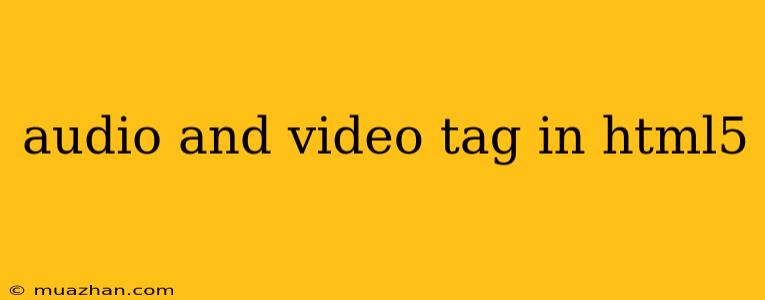Audio and Video Tags in HTML5
HTML5 introduced the <audio> and <video> tags, allowing web developers to embed audio and video content directly into web pages without the need for external plugins like Flash. These tags offer a more streamlined and efficient way to enrich user experiences on the web.
The <audio> Tag
The <audio> tag is used to embed audio content into a web page. It supports various audio formats, including MP3, WAV, OGG, and more. Here's a basic example:
This code embeds an audio file named "audio.mp3." The <source> tag specifies the audio source and its type. If the browser doesn't support the specified format, it will display the alternative text "Your browser does not support the audio element."
The controls attribute adds default playback controls like play/pause, volume, and time slider to the audio element.
The <video> Tag
The <video> tag is used to embed video content into a web page. It also supports various video formats, including MP4, WebM, and OGG. Here's a basic example:
This code embeds a video file named "video.mp4." The width and height attributes set the dimensions of the video player. Similar to the <audio> tag, the controls attribute adds default playback controls.
Common Attributes
Both <audio> and <video> tags share some common attributes:
- controls: Adds default playback controls to the element.
- autoplay: Starts playback automatically when the page loads.
- loop: Makes the audio or video play repeatedly.
- muted: Starts the audio or video muted.
- preload: Specifies how the browser should preload the media.
- "auto": Preload the entire media file.
- "metadata": Preload only the metadata (e.g., title, duration).
- "none": Don't preload any data.
- poster: Specifies an image to display before the video starts playing.
Advantages of HTML5 Audio and Video
- Native Support: HTML5 audio and video tags are natively supported by modern browsers, eliminating the need for plugins.
- Accessibility: The tags provide built-in accessibility features, making media content accessible to users with disabilities.
- Cross-Platform Compatibility: They work consistently across different platforms and devices, enhancing user experience.
- Easy to Implement: The tags are easy to use and require minimal coding, allowing for quick integration into web pages.
Conclusion
HTML5 <audio> and <video> tags offer a powerful and efficient way to embed multimedia content into web pages, enhancing user experience and providing a modern and accessible approach to web development. They have become essential tools for creating dynamic and engaging web content.
